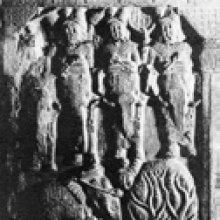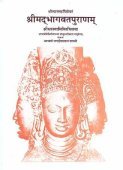Brahmadeva, Brahmadēva, Brahma-deva: 8 definitions
Introduction:
Brahmadeva means something in Buddhism, Pali, Hinduism, Sanskrit, Marathi. If you want to know the exact meaning, history, etymology or English translation of this term then check out the descriptions on this page. Add your comment or reference to a book if you want to contribute to this summary article.
Images (photo gallery)
In Hinduism
Purana and Itihasa (epic history)
Source: archive.org: Puranic EncyclopediaBrahmadeva (ब्रह्मदेव).—A warrior who fought on the side of the Pāṇḍavas against the Kauravas in the battle of Mahābhārata. His duty was to protect the army in the rear. (Mahābhārata Udyoga Parva, Chapter 196, Stanza 25).

The Purana (पुराण, purāṇas) refers to Sanskrit literature preserving ancient India’s vast cultural history, including historical legends, religious ceremonies, various arts and sciences. The eighteen mahapuranas total over 400,000 shlokas (metrical couplets) and date to at least several centuries BCE.
Natyashastra (theatrics and dramaturgy)
Source: Shodhganga: Elements of Art and Architecture in the Trtiyakhanda of the Visnudharmottarapurana (natya)Brahmadeva (ब्रह्मदेव) is the name of the deity associated with Adbhuta or the “wonderful sentiment”, which represents one of the nine kinds of Rasa (“soul of Drama”), according to the Viṣṇudharmottarapurāṇa, an ancient Sanskrit text which (being encyclopedic in nature) deals with a variety of cultural topics such as arts, architecture, music, grammar and astronomy.—According to the Viṣṇudharmottarapurāṇa, Adbhuta is the sentiment that arises from wonder. Vismaya is the sthāyibhāva of adbhuta-rasa. Pīta i.e., yellow is the colour and Brahma is the god of this sentiment. The Viṣṇudharmottarapurāṇa states that adbhutarasa arises from vīrarasa.

Natyashastra (नाट्यशास्त्र, nāṭyaśāstra) refers to both the ancient Indian tradition (shastra) of performing arts, (natya—theatrics, drama, dance, music), as well as the name of a Sanskrit work dealing with these subjects. It also teaches the rules for composing Dramatic plays (nataka), construction and performance of Theater, and Poetic works (kavya).
In Buddhism
Mahayana (major branch of Buddhism)
Source: Wisdom Library: Maha Prajnaparamita SastraBrahmadeva (ब्रह्मदेव) refers to the “Brahmā heavens”, according to the 2nd century Mahāprajñāpāramitāśāstra chapter 32.—Why did the Buddha say that the reward (vipāka) for loving-kindness is to be reborn in the Brahmā heavens? Because the Brahmadevas are venerated by beings, everyone has heard of them and everyone knows them. The Buddha lived in the Indian kingdoms where there were always many Brahmins in whose religion virtuous men were all reborn among the Brahmadevas. When they learn that the devotees of loving-kindness (maitrācārin) are reborn among the Brahmadevas, beings have great faith (śraddhā) and are ready to practice loving-kindness. This is why the Buddha said that devotees of loving-kindness are reborn among the Brahmadevas.
When the Buddha speaks here of the ‘Brahmā heavens’, he means not only the four dhyānas [of rūpadhātu, inhabited by the Brahmadevas] but also the four ārūpyasamāpattis [formless absorptions of ārūpyadhātu, inhabited by the formless deities]. Investigation (vitarka) and analysis (vicāra), [which are eliminated in the dhyānas of ārūpyadhātu], are so difficult to destroy that the Buddha does not speak here about the levels higher than these dhyānas [namely, the four ārūpyasamāpattis].

Mahayana (महायान, mahāyāna) is a major branch of Buddhism focusing on the path of a Bodhisattva (spiritual aspirants/ enlightened beings). Extant literature is vast and primarely composed in the Sanskrit language. There are many sūtras of which some of the earliest are the various Prajñāpāramitā sūtras.
General definition (in Buddhism)
Source: Wisdom Library: BuddhismBrahmadeva (ब्रह्मदेव) refers to one of the descendants of king Sippi: an ancient king from the Solar dynasty (sūryavaṃśa) and a descendant of Mahāsaṃmata, according to the Mahābuddhavaṃsa or Maha Buddhavamsa (the great chronicle of Buddhas) Anudīpanī chapter 1, compiled by Ven. Mingun Sayadaw. Sippi’s son founded Indapattha-nagara and reigned. He and his descendants in that city were twenty-two. The last of these one hundred and seventeen kings was named Brahmadeva. His son also reigned in Ekacakkhu. He and his descendants in that city were fifteen. The last of these fifteen kings was named Baladatta.
Languages of India and abroad
Marathi-English dictionary
Source: DDSA: The Molesworth Marathi and English Dictionarybrahmadēva (ब्रह्मदेव).—m (S) Brahma, the first of the Hindu triad, or the form of the Deity as Fashioner of the universe. 2 A village-god set up by the sōnāra, sutāra, jinagara &c. of a village, and having a Brahman (not a gurava or ghāḍī or rāūḷa) for his priest.
Marathi is an Indo-European language having over 70 million native speakers people in (predominantly) Maharashtra India. Marathi, like many other Indo-Aryan languages, evolved from early forms of Prakrit, which itself is a subset of Sanskrit, one of the most ancient languages of the world.
Sanskrit dictionary
Source: Cologne Digital Sanskrit Dictionaries: Edgerton Buddhist Hybrid Sanskrit DictionaryBrahmadeva (ब्रह्मदेव).—name of a Bodhisattva: Gaṇḍavyūha 443.8.
Source: Cologne Digital Sanskrit Dictionaries: Aufrecht Catalogus Catalogorum1) Brahmadeva (ब्रह्मदेव) as mentioned in Aufrecht’s Catalogus Catalogorum:—Karmavipāka. B. 3, 74.
2) Brahmadeva (ब्रह्मदेव):—Gaṇḍabheruṇḍa [tantric] K. 38.
Source: Cologne Digital Sanskrit Dictionaries: Monier-Williams Sanskrit-English DictionaryBrahmadeva (ब्रह्मदेव):—[=brahma-deva] [from brahma > brahman] m. (also with paṇḍita) Name of various authors, [Catalogue(s)]
Sanskrit, also spelled संस्कृतम् (saṃskṛtam), is an ancient language of India commonly seen as the grandmother of the Indo-European language family (even English!). Closely allied with Prakrit and Pali, Sanskrit is more exhaustive in both grammar and terms and has the most extensive collection of literature in the world, greatly surpassing its sister-languages Greek and Latin.
See also (Relevant definitions)
Partial matches: Deva, Brahma, Teva.
Starts with: Brahmadeva pandita, Brahmadeva Sutta, Brahmadevabhatta, Brahmadevaraja, Brahmadevata.
Ends with: Narabrahmadeva.
Full-text (+20): Baladatta, Narabrahmadeva, Daivisrishti, Brahmadeva Sutta, Gandabherunda, Karanaprakasha, Adikavi, Brahmadeva pandita, Ekacakkhu, Janayitri, Bakabrahma, Uccheda, Kaphalla, Brahmadatta, Narayanasthana, Payoja, Hamsavati, Cauda Indra, Avasthabheda, Mahayajna.
Relevant text
Search found 42 books and stories containing Brahmadeva, Brahma-deva, Brahmā-deva, Brahmadēva; (plurals include: Brahmadevas, devas, Brahmadēvas). You can also click to the full overview containing English textual excerpts. Below are direct links for the most relevant articles:
Maha Prajnaparamita Sastra (by Gelongma Karma Migme Chödrön)
The Bako-brahmā-sutta < [Part 16 - Obtaining the immense longevity and immense radiance of the Buddhas]
III. Fruits of the immeasurables (apramāṇa) < [Class 3: The four immeasurables]
2. Multiple natures < [Part 4 - Understanding identical and multiple natures]
Animal Kingdom (Tiryak) in Epics (by Saranya P.S)
Garga Samhita (English) (by Danavir Goswami)
Verse 1.2.26 < [Chapter 2 - Description of the Abode of Śrī Goloka]
Verse 1.5.36 < [Chapter 5 - The Lord’s Appearance]
Verse 1.3.34 < [Chapter 3 - Description of the Lord’s Appearance]
Jnaneshwari (Bhavartha Dipika) (by Ramchandra Keshav Bhagwat)
Verse 8.18-19 < [Chapter 8 - Akshara-brahman-yoga]
Verse 17.23 < [Chapter 17 - Shraddha-traya-vibhaga-yoga]
Verse 11.15 < [Chapter 11 - Vishvarupa-darshana-yoga]
Buddha-nature (as Depicted in the Lankavatara-sutra) (by Nguyen Dac Sy)
1.2. Āryadeva and the Laṅkāvatārasūtra < [Chapter 3 - The Laṅkāvatārasūtra and Hindu Philosophy]
Vimalakīrti Sutra (by John R. McRae)
Related products

